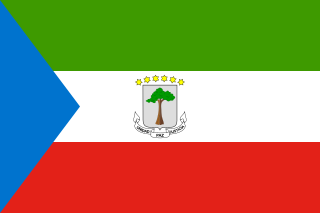
Equatorial Guinea, officially the Republic of Equatorial Guinea, is a country on the west coast of Central Africa, with an area of 28,000 square kilometres (11,000 sq mi). Formerly the colony of Spanish Guinea, its post-independence name evokes its location near both the Equator and the Gulf of Guinea. As of 2021, the country had a population of 1,468,777.

Guinea, officially the Republic of Guinea, is a coastal country in West Africa. It borders the Atlantic Ocean to the west, Guinea-Bissau to the northwest, Senegal to the north, Mali to the northeast, Cote d'Ivoire to the southeast, and Sierra Leone and Liberia to the south. It is sometimes referred to as Guinea-Conakry after its capital Conakry, to distinguish it from other territories in the eponymous region such as Guinea-Bissau and Equatorial Guinea. It has a population of 12.4 million and an area of 245,857 square kilometres (94,926 sq mi).

Guinea-Bissau, officially the Republic of Guinea-Bissau, is a country in West Africa that covers 36,125 square kilometres (13,948 sq mi) with an estimated population of 1,726,000. It borders Senegal to the north and Guinea to the south-east.

The Gulf of Guinea is the northeasternmost part of the tropical Atlantic Ocean from Cape Lopez in Gabon, north and west to Cape Palmas in Liberia. The intersection of the Equator and Prime Meridian is in the gulf.
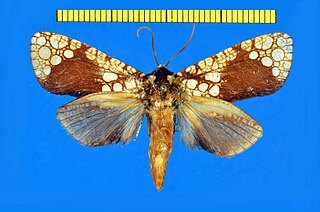
Dudgeonea is a small genus of moths and the only genus of its family, the Dudgeoneidae. It includes six species distributed sparsely across the Old World from Africa and Madagascar to Australia and New Guinea.

The Guinea national football team represents Guinea in men's international football and it is controlled by the Guinean Football Federation. They have never qualified for the FIFA World Cup finals, and their best finish in the Africa Cup of Nations was runners-up in 1976. The team reached the quarter-finals in four recent tournaments. The team represents both FIFA and Confederation of African Football (CAF).
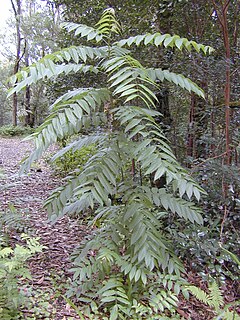
Toona ciliata is a forest tree in the mahogany family which grows throughout southern Asia from Afghanistan to Papua New Guinea and Australia.

Actias is a genus of Saturniid moths, which contains the Asian-American moon moths. Long tails on their hindwings are among their distinctive traits. Other moths with similar appearance are Copiopteryx, Argema and Eudaemonia.

The Saturniinae or saturniines are a subfamily of the family Saturniidae. They are commonly known as emperor moths or wild silk moths. They are easily spotted by the eyespots on the upper surface of their wings. Some exhibit realistic eye-like markings, whilst others have adapted the eyespots to form crescent moon or angular shapes or have lost their wing scales to create transparent windows. They are medium to very large moths, with adult wingspans ranging from 7.5 to 15 cm, in some cases even more. They consist of some of the largest sized Lepidoptera, such as the luna moth, atlas moth, and many more. The Saturniinae is an important source of wild silk and human food in many different cultures.

The following outline is provided as an overview of and topical guide to Guinea:

Palpita vitrealis, common name jasmine moth or white pearl, is a species of moth of the family Crambidae.

Monopis monachella is a moth of the family Tineidae. It is widespread in Eurasia, Africa, India, Sri Lanka, Burma, Sumatra, Java, the Philippines, Taiwan, Japan, New Guinea, Samoa, North America and South America.

Cyligramma latona, the cream-striped owl, is a moth of the family Noctuidae. The species was first described by Pieter Cramer in 1775.
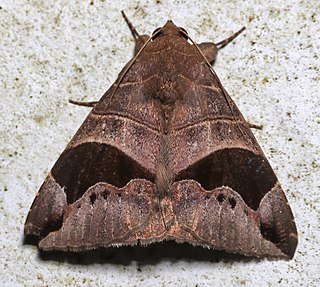
Bastilla joviana is a moth of the family Noctuidae first described by Stoll in 1782. It is found from the Oriental region to the Moluccas and in New Guinea and Australia. It is also present in South Africa.

Exelastis pumilio is a moth of the family Pterophoridae. It has worldwide tropical distribution, including Argentina, Brazil, Colombia, Costa Rica, Cuba, Ecuador, Guadeloupe, Jamaica, Mexico, Puerto Rico, Suriname, Japan, Micronesia, South Africa the Virgin Islands as well as Queensland and New Guinea.
Antarches tessmanni is a moth of the family Pterophoridae that is known from Cameroon, Comoros, Congo, Equatorial Guinea, Ghana, Guinea, Ivory Coast, Madagascar, Malawi, Mauritius, Réunion, South Africa, Tanzania, Uganda, Yemen and Zimbabwe.
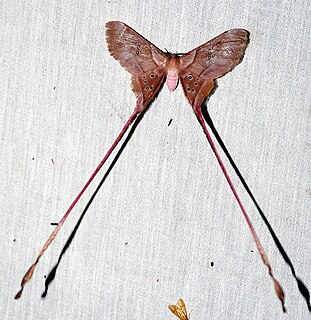
Eudaemonia troglophylla is a species of moth in the family Saturniidae. It is found in Angola, the Democratic Republic of Congo, Equatorial Guinea, the Central African Republic, Nigeria, and Gabon.

Eudaemonia argus is a species of moth in the family Saturniidae. It is found in Africa, in such areas as Gabon, Nigeria, Ivory Coast, Togo, Guinea and Benin. Adults have wings with shades of pinkish to brownish, with several small eyespots on the hindwings; the males have much longer and thinner "tails" on the hindwings than the females.
Eudaemon was an ancient city in Arabia, modern day Aden.















